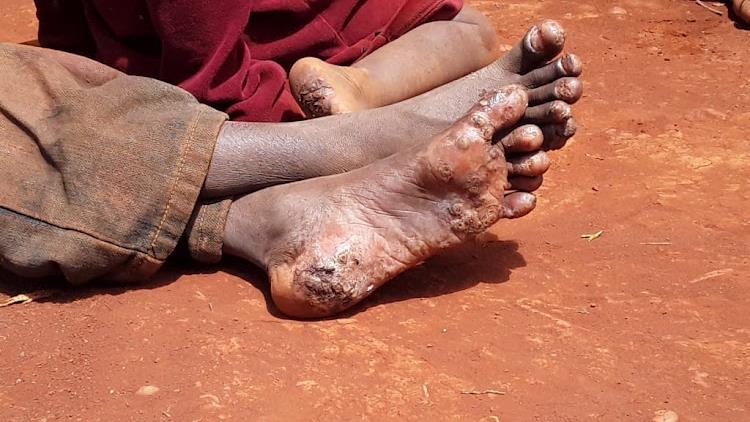 FILE PHOTO
FILE PHOTO
KAMPALA, Uganda
Twelve-year-old Napilu Patrick said he could no longer walk to his primary school about 1 kilometer (0.6 miles) from his home because jiggers were infecting his feet and causing deep wounds.
Apart from eating away at his toes, his fingers were also infected with jiggers and he could not write properly.
"I was studying in class two in Mayefe primary school in Manafa district. I stay with my grandfather. But we have many fleas in the home which enter into our bodies and turn into jiggers. I dropped out of school because I could no longer walk to school due to painful wounds on my feet caused by jiggers," he said sitting under a tree where he was relaxing with other victims at a jiggers treatment center.
What are jiggers?
Jiggers, according to health officer Duncan Kasaija, are brought on by poor hygiene.
“It is a sand flea and loves a dusty environment. It mostly enters feet through nails into toes. They mainly penetrate the body through the feet, ankles, elbows, palms, and buttocks,” he said.
“Severe infections can lead to fibrosis, inflammation, ulceration, and death from tetanus infections due to the wounds caused by jiggers.”
Many infected with jiggers
Napilu is not alone. Thousands of Ugandans are suffering the same fate across the country.
In the eastern district of Bugiri, 70-year-old John Bwire lives in his hut, miserably suffering from jiggers that have not only infected his feet and toes but his buttocks.
He crawls outside and sits in the sun where neighbors bring him food.
"I am living a miserable life. I cannot remove the jiggers from my body because of poor sight. All my children left me and went to the city when they grew up. Their mother abandoned me 10 years ago," said Bwire.
In the western districts of Kisoro and Rukungiri, there are villages where residents are infected with jiggers. Affected villages in the Rukungiri district include Kempanzi, Garuka, Kikonge, and Rushebeya.
A leader in Rushebeya, Euphrahim Mugisha, said: "Many people in this village are suffering from jiggers. Those mostly infected are between 2 to 7 years and the adults between 55 years to 80."
He said sick residents "urgently need help from the government and donors or else people will soon start dying from jiggers."
He attributed the infections to people failing to adhere to basic sanitation standards like keeping dust away from houses and compounds.
Remedy for those infected
Recently Napilu and dozens of others in Mayefe got relief when they were visited by the Sole Hope organization.
The Sole Hope is an NGO headquartered in the US that has embarked on fighting the spread of jiggers.
The group treats those who had severe jiggers cases like Napilu. Patients are admitted in the organization’s admission center where they get treated.
In Uganda, it is located in Jinja in Buwenda village, 80 kilometers (50 miles) from the nation’s capital of Kampala.
Its objective is to improve the quality of life for children and vulnerable people infected with jiggers.
Napilu is among those being treated at the center in Jinja.
Lead social worker of the Sole Hope, Peter Mwonda, told Anadolu Agency that infections in the country are appalling and the group cannot handle it alone.
"The harvest is big, but we are a few laborers. Even when the laborers are there, the resources are minimal given the big number of people infected with jiggers," said Mwonda.
He said that Sole Hope visits all the districts in the country where they get to know cases.
The group usually visits schools where children have jiggers and treat at least 150 per day. If there are more than 159, they go back the following day to treat the rest.
He said apart from treating the victims by removing the jiggers, his group dresses the wounds and offers a pair of shoes to victims in addition to educating them on how to keep away from jiggers.
Mwonda said those who are in critical condition are admitted to the center where they are treated.
At times the group sees severe cases, like recently, when the foot of a patient had 144 jiggers removed.
Anadolu Agency found children as young as 2, pregnant women, and elderly men older than 70 being treated for jiggers infections at the center.
Mwonda said among Sole Hope’s plans is to reach areas where it has not yet reached.
"We want to see a jigger-free community,” he said.


